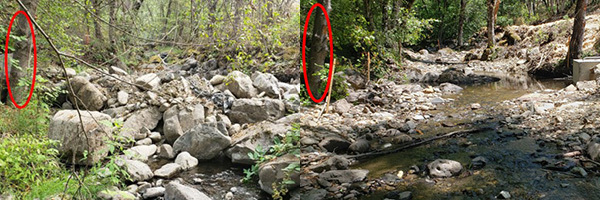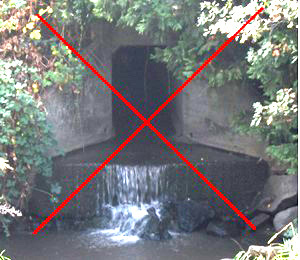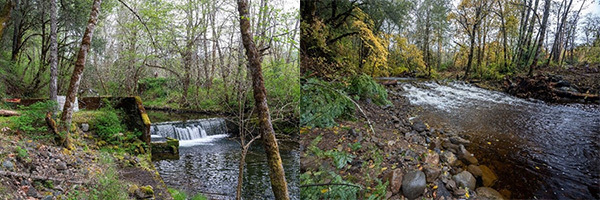|
February 2023
To start the new year, let’s look back at the top 10 conservation highlights of 2022. The work below will produce more wild salmon, steelhead, and other native migratory fish for years to come. Hope you enjoy!
Dan Van Dyke
1. Little Butte Creek water right purchased.
Trout Unlimited purchased the water right for the Butte Creek Mill in Eagle Point. One portion permanently transfers 6.6 ‐ 8.4 cubic feet per second (cfs) of flow instream for the benefit of fish and wildlife (varies seasonally). The remaining 16 cfs continues to be available to power the mill’s historic and unique milling operations and is kept instream when not in use by the mill.
Permanent protections mean the water cannot be claimed or diverted by users upstream and will sustain those flows all the way to the creek’s confluence with the Rogue River. The instream flows will prevent potential de-watering of up to 12 miles of Little Butte Creek during summer and fall, permanently restore flow to an 1,800-foot section of the creek below the mill’s intake and improve passage at the diversion dam’s fish ladder.
This is an exciting development for Little Butte Creek, continuing a string of restoration investment dating back to early Oregon Plan days. Trout Unlimited purchased the water right with funding support from the Oregon Water Resources Department, ODFW’s Fish Restoration and Enhancement Board, and the Medford Water Commission.
2. Corps reservoirs and drought year 2022.
Lost Creek and Applegate reservoirs, both operated by the U.S. Army Corps of Engineers (Corps), depend primarily on rainfall to fill each spring. Both reached abnormally low levels during 2021, and lack of rainfall in early spring 2022 made for a very difficult filling season. Reservoir pool levels dropped very low at Lost Creek (47 feet below normal) and Applegate (46 feet below normal). River flows below the reservoirs dropped to record or near record lows with so much flow being stored in the reservoirs.
In an example of management adapting to difficult conditions, ODFW worked with Oregon Water Resources and the Corps to save nine feet of water and about 3,200 acre-feet of storage at Applegate that normally would have been released during flood season in January.
Lost Creek water levels were managed carefully. Ultimately, a very wet late spring made the biggest difference and Lost Creek reached full pool (Applegate did not). Both reservoirs release water in summer for fish needs—contact ODFW if you would like to learn more.
Did you know?
The lowest flows in recorded history in the Rogue watershed appeared to have occurred during a multi-year drought in the 1920s-1930s. Streamflows dropped very low in 1930 and 1931. Flow in the Rogue River at Gold Ray dropped to 616 cubic feet per second (cfs) in the summer of 1931. The river temperature rose 1°F every six miles through the middle section of the Rogue, and heating in the reservoirs at Gold Ray (3.5°F) and Savage Rapids (2.5°F) dams was documented.
3. Salt Creek push up dams removed.
The Rogue River Watershed Council removed two push-up dams on Salt Creek in 2022. Salt Creek is a cool water tributary of Little Butte Creek. The project merits additional recognition because it completes barrier removal on mainstem Salt Creek! Five other barriers, all included on Oregon’s priority barrier list, were previously removed.
Completed with assistance from Oregon Legislature funds targeting drought and fostering resilience (more information below), the work ensues safe upstream and downstream passage for juvenile coho salmon and wild steelhead. It also will help winter steelhead, Pacific lamprey and Klamath smallscale suckers to spawn in Salt Creek. More wild fish will be produced for years to come.
Before and after photos from one site are shown below.

4. Coleman Creek passage.
The Oregon Department of Transportation removed the lowermost fish passage barrier on Coleman Creek, a tributary of Bear Creek in Phoenix. The undersized culvert (photo below) hindered passage of adult summer steelhead and other spawning migratory fish. And it completely blocked upstream migration by juvenile salmon and steelhead. Contact ODFW if you want to view video of juveniles jumping at this barrier, trying unsuccessfully to migrate upstream. Now that the culvert is removed, more steelhead will be produced!

5. Federal infrastructure funds to improve passage at Bear Creek sewer line.
The Rogue Valley Council of Governments (RVCOG) received a WaterSMART Grant from the Bureau of Reclamation to restore fish passage at an abandoned Medford sewer line and nearby infrastructure on Bear Creek.
The goal is to provide passage for juvenile salmon and steelhead migrating upstream in summer to find cooler water, and to provide low flow passage for adults. Passage for Klamath smallscale suckers and Pacific lamprey also will improve. After completion, ODFW will no longer need to build temporary structures to help fish move upstream.
6. Drought package funding for fish passage barrier removal.
The Oregon Legislature provided ODFW with funding for fish passage barrier removal. Many Rogue projects will benefit:
- Removal of two push up dams on Salt Creek and one on Lost Creek (Little Butte).
- Little Butte water right assessment to address low flow fish passage barriers.
- Dog Creek (Grave Creek) channel restoration design and culvert purchase.
- Fish passage design funding for the Medford Sewer Line (Bear Creek).
- Lovelace Dam Removal (Slate Creek, Applegate) design stage.
- Watts Toppin (Williams Creek, Applegate) fish passage design.
- Laurel Hill (Williams Creek, Applegate) fish passage design.
- Takelma Creek dam and culvert removal (Deer Creek, Illinois) design stage.
7. Rogue Watershed Resiliency Initiative.
Building resilience in the Rogue Watershed is one of several focal areas ODFW identified in 2022 to be a priority for infrastructure funding. Updated climate projections for the Rogue—warmer climate and less snowpack; more frequent and more severe drought; and the possibility of rainfall causing more frequent large flood events —underscore the need to address key factors that limit abundance of native salmon and steelhead.
The primary limiting factors in the interior Rogue are water quantity, water quality, and fish passage. ODFW continues to work with a wide variety of entities to support, initiate and partner on projects to address these primary limiting factors, acquire needed funding, continue the ongoing momentum for restoration in this watershed, and provide Rogue fish the best chance to thrive in an increasingly uncertain, erratic future.
8. Success story! Native fish found throughout Bear Creek despite severe drought.
The annual summer fish distribution check on Bear Creek was completed. Despite severe drought and hot weather in 2022, native fish were found in all locations sampled in 2022, including one site near river mile (RM) 10 and one at RM 2.
Maturation of riparian vegetation on the Bear Creek Greenway, an upgrade of Ashland’s wastewater treatment plant, and removal of the old Jackson Street Dam are the primary drivers of improved conditions for fish in this urban stream.
9. Success story! Passage projects keep wild steelhead spawning in 3+ miles of Jones Creek.
Fish traps operated by Salmon Trout Enhancement Program (STEP) volunteers on upper Jones Creek confirmed successful summer steelhead spawning in the creek’s forks for the past 10 years despite a severe and multi-year drought! This follows work to improve conditions for passage at all barriers on the lower three miles of Jones Creek by the Stream Restoration Alliance (now part of the Rogue River Watershed Council) and leader Dan Delaney.
Prior to the project completion, barriers kept miles of Jones Creek from producing fish. Example—in six years of fish trapping before the restoration projects were all completed, steelhead did not spawn in the forks in two of those years (no fry collected in 2009 or 2012). Worse than that, ODFW found that no fish were able to pass the railroad culvert 500 feet upstream of the mouth of Jones Creek in the winter of 2008-2009. No juvenile salmon or steelhead were observed upstream of the culvert in spring 2009.
Jones Creek provides a perfect example of building resilience one stream at a time. Ask ODFW for more details if interested.
 Jones Creek railroad culvert before after project (photo Stream Restoration Alliance).
10. 3-dam removal project completed in late 2021—a shout out to the Harboldt Dam Project.
I know, I know, this project dates to 2021 and not 2022. But the Harboldt Dam project, led by Water Watch, deserves recognition. A priority barrier was removed in an important fish producing stream, and dams were removed from nearby Welter Creek that were a complete block to fish passage. More salmon and steelhead will be produced as a result!
For the full list of partners dedicated to the Rogue and producing more fish, see Water Watch’s news release.
 Harboldt Dam on Slate Creek before and after removal
|